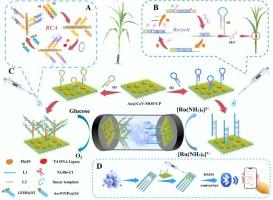Built-in capacitive biosensor based leveraging rolling circle amplification-architected bimetallic nanozyme/glucose oxidase catalytic forest for overcoming sensitivity limits in plant pathogen monitoring
IF 3.7
1区 化学
Q1 CHEMISTRY, ANALYTICAL
引用次数: 0
Abstract
Sugarcane smut, responsible for 35–60 % yield losses and 18–22 % sugar content reductions, demands early diagnostic solutions to mitigate its agricultural impact. Current methods like qPCR remain constrained by limited sensitivity and reliance on centralized laboratory infrastructure. To address these challenges, a field-deployable biosensing platform is developed via the integration of three synergistic innovations: a rolling circle amplification-engineered catalytic “nanozyme forest” that achieves high-density immobilization of Au-Pt bimetallic nanozymes and glucose oxidase active sites; an entropy-driven DNA strand displacement amplification system employing multi-recognition probes for sequence-specific capture and signal amplification of the pathogen biomarker bE4’; and a dual-functional Au@CoV-MOF electrode that simultaneously enables pseudocapacitive energy storage and enhances interfacial electron transfer. The biosensor demonstrates a linear detection range from 10−16 to 10−8 M with a 24.86 aM detection limit, surpassing qPCR sensitivity by two orders of magnitude while maintaining single-base mismatch discrimination. Field validation using sugarcane samples shows complete diagnostic concordance with qPCR results but reduces assay time through elimination of nucleic acid extraction and thermal cycling requirements. By synergizing enzymatic cascade amplification with self-powered energy storage, this work establishes a new paradigm for plant pathogen diagnostics that bridges the gap between laboratory-grade sensitivity and field-deployable practicality.

基于内建电容式生物传感器的滚动圈放大结构——双金属纳米酶/葡萄糖氧化酶催化林在植物病原体监测中克服敏感性限制
甘蔗黑穗病造成35-60%的产量损失和18-22%的含糖量减少,需要早期诊断解决方案来减轻其农业影响。目前的方法,如qPCR,仍然受限于有限的灵敏度和对集中实验室基础设施的依赖。为了应对这些挑战,通过整合三个协同创新,开发了一个可现场部署的生物传感平台:滚动圈放大工程催化“纳米酶森林”,实现Au-Pt双金属纳米酶和葡萄糖氧化酶活性位点的高密度固定化;采用多识别探针的熵驱动DNA链位移扩增系统,用于病原体生物标志物bE4’的序列特异性捕获和信号扩增;以及双功能Au@CoV-MOF电极,该电极同时实现伪电容储能并增强界面电子转移。该生物传感器的线性检测范围为10-16 ~ 10-8 M,检测限为24.86 aM,在保持单碱基错配判别的同时,比qPCR的灵敏度高出两个数量级。甘蔗样品的现场验证显示与qPCR结果完全一致,但通过消除核酸提取和热循环要求减少了分析时间。通过酶级联扩增与自供电能量存储的协同作用,这项工作为植物病原体诊断建立了一个新的范例,弥合了实验室级灵敏度和现场可部署实用性之间的差距。
本文章由计算机程序翻译,如有差异,请以英文原文为准。
求助全文
约1分钟内获得全文
求助全文
来源期刊

Sensors and Actuators B: Chemical
工程技术-电化学
CiteScore
14.60
自引率
11.90%
发文量
1776
审稿时长
3.2 months
期刊介绍:
Sensors & Actuators, B: Chemical is an international journal focused on the research and development of chemical transducers. It covers chemical sensors and biosensors, chemical actuators, and analytical microsystems. The journal is interdisciplinary, aiming to publish original works showcasing substantial advancements beyond the current state of the art in these fields, with practical applicability to solving meaningful analytical problems. Review articles are accepted by invitation from an Editor of the journal.
 求助内容:
求助内容: 应助结果提醒方式:
应助结果提醒方式:


